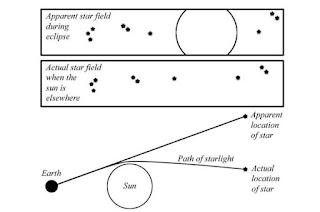Gravitational lensing- sounds very sci-fi eh!
Believe me it's not a thing that you cannot get your head around because you observe it everyday
Let's figure out what it is!
So when it comes to Universe and the way we can know about it , telescopes are the first thing that come in our minds. But you know what! Nature has got its own ways to reveal us the secrets and one of them is Gravitational Lensing
What had Einstein said-
1.Light travels in straight lines -
These straight lines are called geodesics in spacetime.
2.Mass tells space time to curve and the curved spacetime tells mass how to move -Imagine the whole spacetime like a fabric(actually no fabric is there but this simple analogy helps a lot in understanding the complex concepts).
Anything you put on that fabric creates a dimple on it ..so yeah get excited you too are creating a dimple on it. The fabric is not an ordinary one ! It's rigid one its noticeable with massive objects of astronomical scales only.
Here's your recipe for gravitational lensing-
Take some galaxy or star which you want to observe so it becomes your source
Take a massive astronomical object - for producing significant bending of spacetime
and you- for observing gravitational lensing.
Place them in a way -
You - Massive astronomical object - Star which you want to observe
And wallah you have gravitational lensing.
Here's the explanation -
The light from the source gets bent due to the warping of spacetime around the massive astronomical object. We see the lights travelling in straight paths so what we actually see as the image of the object is the lensed image/images
You can now play with it
Vary the mass of the source bending the light and you have three types of Lensing effects -
Strong Lensing - For this the lens should be very powerful like cluster of galaxies and the light source should be sufficiently near. For point like sources there maybe multiple images whereas for extended background emissions there can be rings. The image is magnified too
Look here at the beautiful Einstein’s ring-
When the source , lens and observer all will be at a straight path then due to uniform bending of light from the source by the lens, we get a ring like structure.
Weak Lensing - As the name suggests , it occurs when the lens isn't powerful enough to produce ring , multiple images , instead it leads to the stretching/magnification or extra elliptical appearance of the source. It is useful in obtaining the galaxy mass distributions and by taking into account the magnification of the light from the lens and it’s size and shape we can also detect the presence of dark matter.
Microlensing – Source isn’t powerful enough to produce distortion in the image of source. So the light of the source changes with time. The source of lensing is very faint like a star or a planet and/or the source and lens are far away. We use this to detect the presence of the faint/very far away stars for there is significant variation in the magnification of the light from star over time.
Another one is cluster lensing in which the image produced is the kind of combination of weak and strong lensing.
 |
| Bending of Light 😯 |
 |
| Beginning of Einstein's era |
Remember everytime you look around, the things aren’t exactly at the same position(they even aren’t what you see them at the moment..but that’s the story for some other time)
Every patch of the sky tells a story…can you tell??Refrences-





















Its good to leave references, also images are great ... great job another topic and again not in a book read language. Its nice to see such content
ReplyDeletehappy to meet the expectations!
DeleteGreat .... Understood it very well
ReplyDeleteappreciation means a lot!
DeleteGreat work .. concise and crisp
ReplyDeletethanks reader!
DeleteInformative ✨
ReplyDeletekeep exploring!
DeleteGreat work
ReplyDeleteKeep exploring
DeleteThanks Reader!
ReplyDeleteKnowledgeable
ReplyDeletemeans a lot reader!
Delete